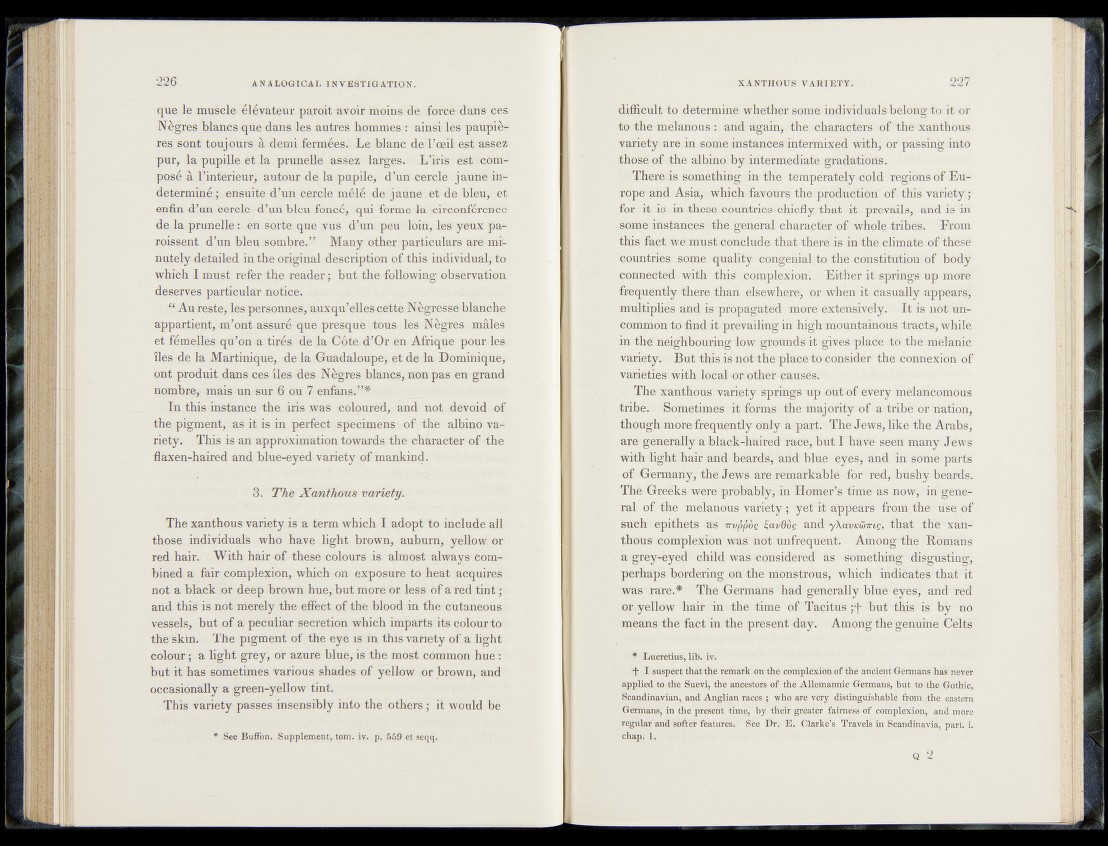
que le muscle élévateur, paroit avoir moins' de force dans ces
Nègres blancs que dansées autres hommes : ainsi*lès paupiè^-
res sont toujours à^demi fermées.' Xe blanc de;l?;oeikesfi’«ssffiZ‘
pur, la pupille et la. prunelle assez larges. L’iris * estc*composé
à l’interieur, autour de lapupile; d ’un cercle jaune indéterminé;
ensuite d ’un cercle mêlé ;de jaune ert
enfin d’un cercle d’un bleu foncé, qui forme la circonférence
de la prunellè^ énrsorte^qiee vus d'un* peu loin, les: yeux pa-
roissent d’un bleu sombre.” Many other particulars are minutely
detailed in the original description of this individual, to
which I must refer the reader; but the following*observation
deserves particular notice, p
“ Au reste, les personnes, auxquelles cette Négresse blanche
appartient, m’ont assuré que presque tous lësfNègrèSt mâles
et fémelles qu’on a tirés de la Côte d’Or en Afrique pour les
îles de la Martinique, de la Guadaloupe; et de la Dominique,
ont produit dans ces îles des Nègres blancs, non pas en grand
nombre, mais un sur 6 ou 7 enfans.”#
In this instance the iris was coloured, and not, devoid of
the pigment, as it is in perfect specimens of the • albino variety.
Tin© is an approximation towards the character of-the
flaxen-haired and blue-eyed „variety ofmankind,
3. The Xanthous variety. -
The xanthous variety is a term which I adopt'to include all
those individuals who have light brown, auburn, yellower
red hair. With hair of these colours is almost always combined
a fair complexion, which on exposure to heat acquires
not a black or deep brown hue, but more or less of a red tint ;
and this is not merely the effect of the blood in the cutaneous
vessels, but of a peculiar secretion which imparts its colour to
the skin. The pigment of the eye is in this variety of a light
colour ; a light grey, or azure blue, is the most common hue :
but it has sometimes various shades of yellow or brown, and
occasionally a green-yellow tint.
This variety passes insensibly into the others ; it would be
See Buffon. Supplement, tom. iv. p. 559 et seqq.
difficult to determine whether, sotme-individuals belong to it or
to th e melanous : and again, the characters of the xanthous
•variety are in -some .-instances intermixed with, or passing into
those of- thte hlbino’by intermediate gradations.
UiThereds something in the:* temperatelyicold Regions of Europe
ahd - Asia, which favours the production of this variety ;
for itnsrtin theseJcountrie& chiefly that it prevails';--and is in
some "»stances ï thé general character of whole tribes> r- Erom
this fact/we mu stconclude’ that therétts d’tóthé climate*of these
countries'"■some qualify eongemafito^fhe^ceaistitution of body
connected with thiB ccomplexiioni »-^Either it springs up more
frequently there than elsewhere;, or'when iteasuallySahpëHrsf
multipMés and is propagated more' extensively.'' Itüsf'noti-un-
common to find it prevailing in hi gh'mountainous tracts, while
in the neighbouring loW* grounds i t gives place to thèsmelanië
variety.' But this is not the place to1 consider the connexion of’
varieties’ with local o fo th ef causes.' '
The xanthoUs variety sprifigs’iflp out of "every melancomous
tribe; £'jSómetiteÉɧ it forms the majority Gf a*tribe*ov“nation,
though mote frequently only a part. f like the Afabs,
are generally a black-haired race, but I haVe< së'en-’mady Jéwé
with light hair and beards*, and' blué“ëy&s, and in some parts
of'Germany, the Jews are remarkable for red, bushy beards.
The Greeks were probably, in Homer’s time as now, mgehef
ral of the melanous Variety; yet it appears from,the use of
such epithets as* 'mpfitie favdog and yXcivKSwie, that th e xanthous
complexion was not unfrequent. Among the Romans
a grey-eyed child was- Considered as- something disgusting;
perhaps bordering on the monstrous, which -indicates that it
was rare.* The Germans had, generally blue;eyës,' and red
or yellow hair ’in the time of Tacitus jj* but this is by no
means the fact in the present day. Among the genuine Celts
* Lucretius, lib. iv.
-f- I suspect that the remark on the complexion of the ancient Germans has never
applied to the Spevi, the ancestors of the Allemannic Germans, hut to the Gothic,
Scandinavian, and Anglian races ; who are very .distinguishable from the eastern
Germans, in the présent ïimé, by their greater fairness of complexion, and more
regular and softer features. See Dr. E. Clarke’s Travels in Scandinavia, part. i.
chap. 1 .